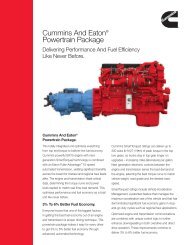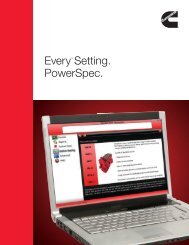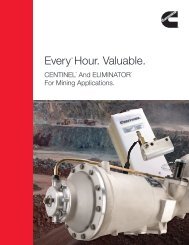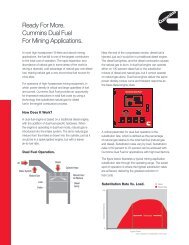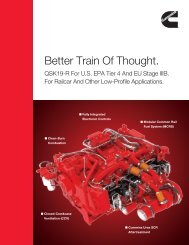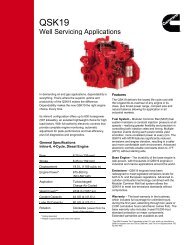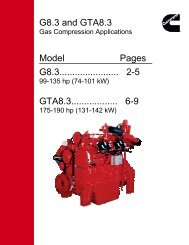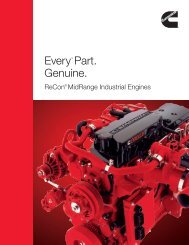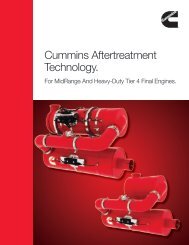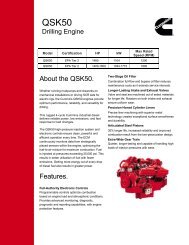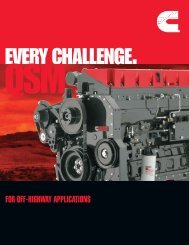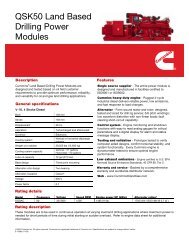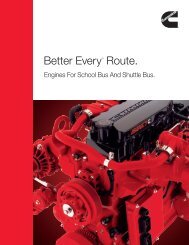View - Cummins Engines
View - Cummins Engines
View - Cummins Engines
You also want an ePaper? Increase the reach of your titles
YUMPU automatically turns print PDFs into web optimized ePapers that Google loves.
The QSK95 is built ultra-strong<br />
with a long life-to-overhaul and<br />
can be rebuilt multiple times.<br />
A Better Train Of Thought.<br />
For locomotive builders looking for<br />
a new-power approach to achieve<br />
cleaner, more efficient performance, the<br />
QSK95 engine arrives on time to deliver<br />
radically improved power capability for<br />
both freight and passenger operations.<br />
With over 4000-hp (2983 kW) output<br />
from 16 cylinders, the QSK95 surpasses<br />
other high-speed engines. In terms<br />
of emissions capability and compact<br />
installation, the QSK95 is way ahead<br />
of much larger medium-speed engines<br />
with a similar output.<br />
For commuter and intercity locomotives,<br />
the 4200-hp (3132 kW) capable QSK95<br />
is applied with an auxiliary <strong>Cummins</strong> rail<br />
engine to provide electrical hotel power<br />
to the passenger coaches.<br />
High power density, together with<br />
<strong>Cummins</strong> space-saving exhaust<br />
aftertreatment, creates a lighter, fully<br />
integrated emissionized power solution<br />
designed to meet all of the requirements<br />
for new high-speed passenger<br />
locomotives. Operators of multipurpose<br />
freight locomotives from 3600 hp<br />
(2684 kW) will find the QSK95 is a costeffective<br />
and very dependable power<br />
solution – keeping train operations on<br />
schedule.<br />
The QSK95 delivers even more fuel<br />
savings to line-haul freight applications<br />
when used together with a smaller<br />
<strong>Cummins</strong> locomotive engine for full<br />
pulling power when you need it, and<br />
the best possible fuel economy at lower<br />
power levels. A smart power-sharing<br />
system transfers work between the two<br />
engines to match the locomotive duty<br />
cycle, so that overall fuel and operational<br />
costs are significantly reduced – an<br />
advantage that represents a better train<br />
of thought over current conventionally<br />
powered locomotives.<br />
<strong>Cummins</strong> own exhaust aftertreatment<br />
system is purpose-designed for<br />
locomotive installations, using Selective<br />
Catalytic Reduction (SCR) technology.<br />
This unique, modular system minimizes<br />
space claim and improves fuel efficiency,<br />
lowering the overall cost of operation.<br />
Without exhaust aftertreatment, the<br />
QSK95 engine meets Tier 3 locomotive<br />
emissions and is ideally suited for<br />
locomotives operating anywhere in the<br />
world, however tough the conditions.<br />
The engine is built ultra-strong for this<br />
purpose, with very long life-to-overhaul<br />
offering a major reduction in total<br />
life cycle costs.<br />
The space-efficient design of the QSK95<br />
enables easier service accessibility than<br />
is typical for engines of this output,<br />
as all key cooling, oil and fuel system<br />
components are externally enginemounted,<br />
providing rapid access.



